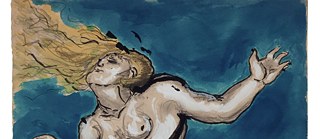Exhibition
Fritz Ascher: Expressionist

Fritz Ascher: Expressionist presents works by this German Jewish artist, who lived through the Weimar Republic, the Nazi regime, and into the postwar years. With the support of prominent Berlin painter Max Liebermann, Fritz Ascher (1893–1970) studied in Berlin before traveling to Oslo, where he met Edvard Munch. During a prolonged stay in Munich, he associated with the artists who contributed to Simplicissimus magazine, and back in Berlin, he fell in with the artists of Die Brücke. His early work is steeped in old myths, spirituality, and reflections on the human condition.
From 1933 he was forbidden to produce, exhibit, or sell his art. Interned at the Sachsenhausen Concentration Camp in 1938, he survived the Nazi era mostly in hiding, writing poetry. After 1945 he returned to painting, expressing his inner turmoil in colorful, mystical landscapes devoid of human figures. The exhibition comprises 75 paintings and works on paper, ranging from Ascher’s early academic studies to his final landscapes.
Events
January 16, 6:30pm
Gallery Conversation
With Rachel Stern, Director of the Fritz Ascher Society for Persecuted, Ostracized, and Banned Art and curator of Fritz Ascher.
January 30, 6:00pm
Panel Discussion: European Modernism and Spirituality
Moderated by Rose-Carol Washton Long, Professor Emerita of 19th and 20th Century European Art, CUNY Graduate Center, with speakers Elizabeth Berkowitz, Mellon/ACLS Public Fellow, Rockefeller Archive Center; Matthew Drutt, editor, writer and independent curator; and Ori Z. Soltes, Teaching Professor of Jewish Civilization, Georgetown University.
February 6, 6:30pm
Gallery Conversation
With Rachel Stern, Director of the Fritz Ascher Society for Persecuted, Ostracized, and Banned Art and curator of Fritz Ascher.
February 12, 6:30pm
Conversation: Hiding: Jewish Life in Nazi Germany
What was it like to be a Jew in Nazi Germany? For those trapped in the Nazi terror regime, mere survival became a nightmare. Those who went underground, including Fritz Ascher, endured the terrors of nightly bombings and the even greater fear of being discovered by the Nazis. All were pressed to the limits of human endurance and loneliness. Marion Kaplan, Skirball Professor of Modern Jewish History, NYU, and Rachel Stern, Director of the Fritz Ascher Society for Persecuted, Ostracized, and Banned Art and Curator of Fritz Ascher, will discuss.
Februar 14, 6:30pm
Film Screening: People on Sunday (1930)
What was it like to be a Jew in Nazi Germany? For those trapped in the Nazi terror regime, mere survival became a nightmare. Those who went underground, including Fritz Ascher, endured the terrors of nightly bombings and the even greater fear of being discovered by the Nazis. All were pressed to the limits of human endurance and loneliness. Marion Kaplan, Skirball Professor of Modern Jewish History, NYU, and Rachel Stern, Director of the Fritz Ascher Society for Persecuted, Ostracized, and Banned Art and Curator of Fritz Ascher, will discuss.
February 28, 6:30pm
Conversation: Methodology, Resources, Issues, and Challenges in Nazi-Era Provenance Research
Sharon Flescher, PhD, Executive Director, International Foundation for Art Research (IFAR), and Lynn Rother, PhD, Senior Provenance Specialist, Museum of Modern Art, will discuss Nazi-era provenance research as it relates to museums, collectors, and the art market.
April 3, 6:30pm
Gallery Conversation
With English Cook, Graduate Curatorial Assistant, Grey Art Gallery, and Ph.D. Candidate, Institute of Fine Arts, NYU.
Fritz Ascher: Expressionist was organized by the Fritz Ascher Society for Persecuted, Ostracized and Banned Art, Inc. and curated by director Rachel Stern. The exhibition is part of Wunderbar Together: The Year of German-American Friendship 2018/19, an initiative of the Federal Foreign Office of Germany and the Goethe-Institut, with the support of the Federation of German Industries (BDI). Support for the catalogue was provided by Reinwald GmbH, Leipzig. The presentation at the Grey Art Gallery is made possible in part by the New York State Council on the Arts with the support of Governor Andrew M. Cuomo and the New York State Legislature; Ruth Ivor Foundation; Charina Endowment Fund; Violet Jabara Charitable Trust; Abby Weed Grey Trust; and the Grey’s Director’s Circle, Inter/National Council, and Friends.
Details
Grey Art Gallery
New York University
100 Washington Square East
New York, NY 10003
Language: English
Price: $5 suggested admission
+1 212 998-6780 greyartgallery@nyu.edu
Hours:
Tue, Thu, & Fri: 11am-6pm
Wed: 11am-8pm
Sat: 11am-5pm
Closed Sun & Mon